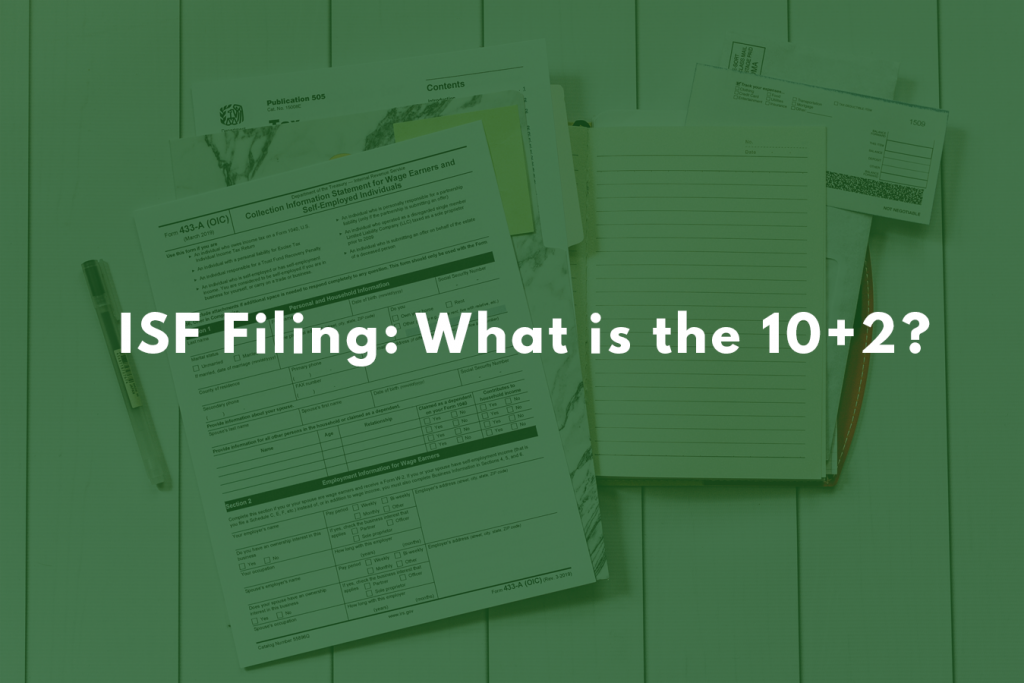First introduced in 2009 and fully in effect since 2010, ISF filing is a crucial part of any importing any cargo coming into the United States by ocean carrier.
While ISF has no bearing on your cargo’s admissibility and does not generally influence trade enforcement, US Customs and Border Protection (CBP) will compare the data with your customs entry to assess risk. Getting it right means avoiding extra scrutiny and costly fines. If you’d like expert guidance on your ISF filing, get in touch with us!
ISF Filing: What is the 10+2 Form?
Also known as the 10+2, Importer Security Filing (ISF filing) is required for any commercial imports entering the country. It is not required when you’re importing by air or truck. The nickname 10+2 comes from the data required to file properly.
Your ISF must be filed at least 24 hours in advance of your cargo leaving port in the original destination. We recommend giving it more time than that if you can; 72 hours is a safer bet, but really, as soon as possible is best.
A customs bond is required for entry on ISF filings. You can use either a continuous or single entry bond, but we recommend using a continuous bond. With a single entry bond, you’ll be asked to purchase a separate ISF bond. The continuous bond covers both your ISF and your customs entry.
Bulk cargo, like grain or coal imported in bulk, is exempt from any ISF filing requirements.
How to File ISF 10+2
While you are ultimately responsible for your ISF filing, we can complete the document for you as expert customs brokers. Gathering, checking, and compiling all the required information is time consuming and getting it wrong can land you penalties, so you want to be sure you get it right.
Filing late with a single entry bond may mean being asked to put up $5,000 in collateral, so it’s smart to make sure you’re using a continuous entry bond and filing as soon as you can.
Penalties start at $5,000 and cap at $10,000. You can be penalized for:
- Failure to file ISF
- Late ISF filing
- Inaccurate ISF filing
- Incomplete ISF filing
- Failure to withdraw an ISF
In order to successfully file your ISF, you will need:
- Seller contact information
- Buyer contact information
- Importer of record number (or FTZ applicant identification number)
- Consignee numbers
- Manufacturer/supplier
- Destination/Ship to party
- Country of Origin
- Harmonized Tariff Schedule number
You have until 24 hours before a ship arrives at a US port to submit 2 additional required pieces of data, supplied by the carrier:
- Container stuffing location
- Consolidator
Filing is done electronically. It will need to be submitted at the lowest bill of lading level — such as house or regular bill — that is filed in the Automated Manifest System (AMS). Again, it needs to be filed at least 24 hours before the ship leaves its port of origin.
You will receive a message of acceptance (or rejection) when CBP receives your ISF filing, so watch out and make sure they got it. Watch out, because CBP will accept incomplete filings without notice that you’re missing pieces of data. You’ll avoid any potential problems by using a customs broker like Clearit, but if you’re self-filing, make sure you triple check your work.
ISF 5 Filing
The 10+2 version of the ISF is required for ocean cargo intended to land in the United States. Cargo in transit through the United States via ocean routes has its own ISF requirement.
Ocean cargo traveling as Foreign Remaining on Board (FROB), Immediate Exportation (IE), or Transport and Exportation (TE) must electronically submit an ISF 5 filing with 5 pieces of data:
- Booking party
- Foreign port of unlading
- Place of delivery
- Destination/Ship to party
- Harmonized tariff schedule number






